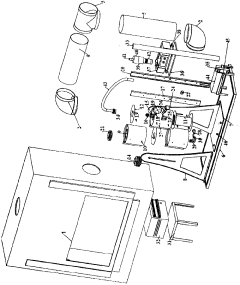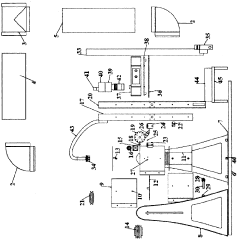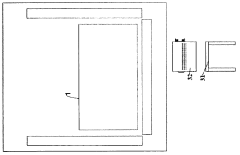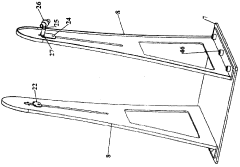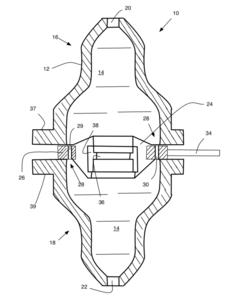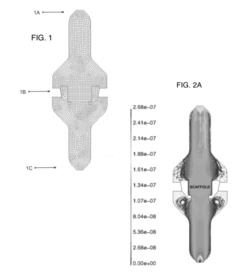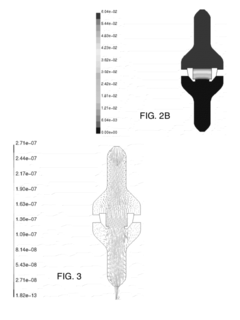Breakthroughs in Laminar Flow for Renewable Energy Systems
JUL 10, 20259 MIN READ
Generate Your Research Report Instantly with AI Agent
Patsnap Eureka helps you evaluate technical feasibility & market potential.
Laminar Flow in Renewable Energy: Background and Objectives
Laminar flow, a fundamental concept in fluid dynamics, has gained significant attention in the realm of renewable energy systems. This phenomenon, characterized by smooth and predictable fluid motion, has become a crucial area of study for enhancing the efficiency and performance of various renewable energy technologies. The evolution of laminar flow research in the context of renewable energy can be traced back to the early 20th century, with pioneering work in fluid mechanics laying the groundwork for modern applications.
As renewable energy sources have become increasingly important in addressing global climate challenges, the optimization of fluid dynamics in energy systems has emerged as a key focus area. Laminar flow, in particular, has shown promise in improving the efficiency of solar thermal collectors, wind turbines, and hydroelectric systems. The controlled nature of laminar flow allows for better heat transfer, reduced drag, and enhanced energy extraction in these applications.
The technological trajectory of laminar flow in renewable energy systems has been marked by several significant milestones. Early research focused on understanding the fundamental principles of laminar flow and its potential benefits in energy conversion processes. As computational fluid dynamics (CFD) tools advanced, researchers gained the ability to model and simulate laminar flow behaviors with unprecedented accuracy, leading to more sophisticated designs in renewable energy technologies.
Recent years have witnessed a surge in research aimed at harnessing laminar flow for improving the performance of renewable energy systems. This includes the development of novel surface textures and coatings to promote laminar flow in solar collectors, the design of airfoil shapes that maintain laminar flow conditions for wind turbines, and the optimization of water flow patterns in hydroelectric turbines.
The primary objectives of current research in this field are multifaceted. Scientists and engineers are striving to extend the range of conditions under which laminar flow can be maintained in renewable energy applications, thereby expanding the operational efficiency of these systems. There is also a strong focus on developing innovative materials and structures that can induce and sustain laminar flow in challenging environments.
Furthermore, researchers are exploring the integration of smart technologies and adaptive control systems to dynamically manage fluid flow characteristics in response to changing environmental conditions. This approach aims to maximize energy harvesting potential across a wide range of operational scenarios, ultimately contributing to the increased adoption and effectiveness of renewable energy solutions.
As renewable energy sources have become increasingly important in addressing global climate challenges, the optimization of fluid dynamics in energy systems has emerged as a key focus area. Laminar flow, in particular, has shown promise in improving the efficiency of solar thermal collectors, wind turbines, and hydroelectric systems. The controlled nature of laminar flow allows for better heat transfer, reduced drag, and enhanced energy extraction in these applications.
The technological trajectory of laminar flow in renewable energy systems has been marked by several significant milestones. Early research focused on understanding the fundamental principles of laminar flow and its potential benefits in energy conversion processes. As computational fluid dynamics (CFD) tools advanced, researchers gained the ability to model and simulate laminar flow behaviors with unprecedented accuracy, leading to more sophisticated designs in renewable energy technologies.
Recent years have witnessed a surge in research aimed at harnessing laminar flow for improving the performance of renewable energy systems. This includes the development of novel surface textures and coatings to promote laminar flow in solar collectors, the design of airfoil shapes that maintain laminar flow conditions for wind turbines, and the optimization of water flow patterns in hydroelectric turbines.
The primary objectives of current research in this field are multifaceted. Scientists and engineers are striving to extend the range of conditions under which laminar flow can be maintained in renewable energy applications, thereby expanding the operational efficiency of these systems. There is also a strong focus on developing innovative materials and structures that can induce and sustain laminar flow in challenging environments.
Furthermore, researchers are exploring the integration of smart technologies and adaptive control systems to dynamically manage fluid flow characteristics in response to changing environmental conditions. This approach aims to maximize energy harvesting potential across a wide range of operational scenarios, ultimately contributing to the increased adoption and effectiveness of renewable energy solutions.
Market Analysis for Laminar Flow Applications
The market for laminar flow applications in renewable energy systems has been experiencing significant growth in recent years, driven by the increasing demand for more efficient and sustainable energy solutions. Laminar flow, characterized by smooth and predictable fluid motion, plays a crucial role in various renewable energy technologies, particularly in wind turbines, solar thermal systems, and hydroelectric power generation.
In the wind energy sector, laminar flow research has led to the development of more aerodynamic turbine blades, resulting in improved energy capture and reduced noise pollution. This has expanded the potential market for wind farms, especially in areas with stricter environmental regulations. The global wind energy market is projected to grow substantially over the next decade, with laminar flow innovations contributing to this expansion.
Solar thermal systems have also benefited from advancements in laminar flow technology. Improved heat transfer efficiency in solar collectors and thermal storage systems has increased the viability of concentrated solar power (CSP) plants. This has opened up new market opportunities in regions with high solar irradiance, particularly in developing countries seeking to diversify their energy mix.
Hydroelectric power generation, another significant sector in renewable energy, has seen improvements through laminar flow applications. Enhanced turbine designs that optimize water flow have increased energy conversion efficiency, making small-scale hydroelectric projects more economically viable. This has expanded the market for micro and pico hydropower systems in remote and off-grid locations.
The marine renewable energy sector, including tidal and wave energy systems, is an emerging market where laminar flow research is showing promise. Improved understanding of fluid dynamics in these environments is leading to more efficient energy capture devices, potentially unlocking vast untapped energy resources in coastal regions worldwide.
In the broader context of the renewable energy market, laminar flow applications are contributing to the overall trend of increased efficiency and reduced costs. This is crucial for the competitiveness of renewable energy sources against traditional fossil fuels. As governments worldwide implement stricter emissions regulations and renewable energy targets, the demand for technologies that can maximize energy output while minimizing environmental impact is expected to grow significantly.
The market for laminar flow applications extends beyond direct energy generation. Industries such as HVAC, water treatment, and industrial processes are increasingly adopting laminar flow principles to improve energy efficiency. This cross-sector applicability is expanding the total addressable market for laminar flow technologies and expertise.
In the wind energy sector, laminar flow research has led to the development of more aerodynamic turbine blades, resulting in improved energy capture and reduced noise pollution. This has expanded the potential market for wind farms, especially in areas with stricter environmental regulations. The global wind energy market is projected to grow substantially over the next decade, with laminar flow innovations contributing to this expansion.
Solar thermal systems have also benefited from advancements in laminar flow technology. Improved heat transfer efficiency in solar collectors and thermal storage systems has increased the viability of concentrated solar power (CSP) plants. This has opened up new market opportunities in regions with high solar irradiance, particularly in developing countries seeking to diversify their energy mix.
Hydroelectric power generation, another significant sector in renewable energy, has seen improvements through laminar flow applications. Enhanced turbine designs that optimize water flow have increased energy conversion efficiency, making small-scale hydroelectric projects more economically viable. This has expanded the market for micro and pico hydropower systems in remote and off-grid locations.
The marine renewable energy sector, including tidal and wave energy systems, is an emerging market where laminar flow research is showing promise. Improved understanding of fluid dynamics in these environments is leading to more efficient energy capture devices, potentially unlocking vast untapped energy resources in coastal regions worldwide.
In the broader context of the renewable energy market, laminar flow applications are contributing to the overall trend of increased efficiency and reduced costs. This is crucial for the competitiveness of renewable energy sources against traditional fossil fuels. As governments worldwide implement stricter emissions regulations and renewable energy targets, the demand for technologies that can maximize energy output while minimizing environmental impact is expected to grow significantly.
The market for laminar flow applications extends beyond direct energy generation. Industries such as HVAC, water treatment, and industrial processes are increasingly adopting laminar flow principles to improve energy efficiency. This cross-sector applicability is expanding the total addressable market for laminar flow technologies and expertise.
Current Challenges in Laminar Flow Technology
Laminar flow technology in renewable energy systems faces several significant challenges that hinder its widespread adoption and optimal performance. One of the primary obstacles is the difficulty in maintaining laminar flow conditions in large-scale applications. As renewable energy systems often require substantial infrastructure, scaling up laminar flow technologies while preserving their efficiency proves to be a complex task.
The sensitivity of laminar flow to external disturbances poses another major challenge. Environmental factors such as wind, temperature fluctuations, and surface irregularities can disrupt the delicate balance required for laminar flow, leading to reduced efficiency and increased energy losses. This sensitivity makes it challenging to implement laminar flow technologies in diverse and unpredictable real-world settings.
Material limitations also present a significant hurdle in advancing laminar flow applications. The need for smooth, non-porous surfaces with specific properties to maintain laminar flow often conflicts with the durability and cost-effectiveness requirements of renewable energy systems. Developing materials that can withstand harsh environmental conditions while promoting laminar flow remains an ongoing challenge for researchers and engineers.
Energy losses due to friction and heat transfer in laminar flow systems continue to be a concern. While laminar flow generally results in lower friction compared to turbulent flow, the cumulative effect of friction over large surface areas can still lead to substantial energy losses. Minimizing these losses without compromising the integrity of the laminar flow is a delicate balancing act that requires innovative solutions.
The integration of laminar flow technologies with existing renewable energy infrastructure presents another challenge. Retrofitting current systems or designing new ones that incorporate laminar flow principles often requires significant modifications and investments. This integration challenge can slow down the adoption of laminar flow technologies in the renewable energy sector.
Measurement and control of laminar flow in real-time operational conditions remain technically challenging. The lack of robust, cost-effective sensors and control systems capable of monitoring and maintaining laminar flow in dynamic environments hampers the optimization of these systems. Developing advanced monitoring and control technologies is crucial for the widespread implementation of laminar flow in renewable energy applications.
Lastly, the interdisciplinary nature of laminar flow applications in renewable energy systems presents a challenge in terms of knowledge integration and collaboration. Bridging the gap between fluid dynamics, materials science, energy engineering, and environmental studies requires a concerted effort from diverse fields, which can be organizationally and intellectually demanding.
The sensitivity of laminar flow to external disturbances poses another major challenge. Environmental factors such as wind, temperature fluctuations, and surface irregularities can disrupt the delicate balance required for laminar flow, leading to reduced efficiency and increased energy losses. This sensitivity makes it challenging to implement laminar flow technologies in diverse and unpredictable real-world settings.
Material limitations also present a significant hurdle in advancing laminar flow applications. The need for smooth, non-porous surfaces with specific properties to maintain laminar flow often conflicts with the durability and cost-effectiveness requirements of renewable energy systems. Developing materials that can withstand harsh environmental conditions while promoting laminar flow remains an ongoing challenge for researchers and engineers.
Energy losses due to friction and heat transfer in laminar flow systems continue to be a concern. While laminar flow generally results in lower friction compared to turbulent flow, the cumulative effect of friction over large surface areas can still lead to substantial energy losses. Minimizing these losses without compromising the integrity of the laminar flow is a delicate balancing act that requires innovative solutions.
The integration of laminar flow technologies with existing renewable energy infrastructure presents another challenge. Retrofitting current systems or designing new ones that incorporate laminar flow principles often requires significant modifications and investments. This integration challenge can slow down the adoption of laminar flow technologies in the renewable energy sector.
Measurement and control of laminar flow in real-time operational conditions remain technically challenging. The lack of robust, cost-effective sensors and control systems capable of monitoring and maintaining laminar flow in dynamic environments hampers the optimization of these systems. Developing advanced monitoring and control technologies is crucial for the widespread implementation of laminar flow in renewable energy applications.
Lastly, the interdisciplinary nature of laminar flow applications in renewable energy systems presents a challenge in terms of knowledge integration and collaboration. Bridging the gap between fluid dynamics, materials science, energy engineering, and environmental studies requires a concerted effort from diverse fields, which can be organizationally and intellectually demanding.
Existing Laminar Flow Solutions
01 Laminar flow control in fluid systems
Techniques for controlling and maintaining laminar flow in various fluid systems to improve flow efficiency. This includes design considerations for pipes, channels, and other fluid conduits to minimize turbulence and ensure smooth, predictable fluid movement.- Laminar flow control in fluid systems: Techniques for controlling and maintaining laminar flow in fluid systems to improve flow efficiency. This includes design considerations for channels, pipes, and other fluid conduits to minimize turbulence and ensure smooth, predictable fluid movement.
- Flow measurement and analysis in laminar conditions: Methods and devices for accurately measuring and analyzing fluid flow under laminar conditions. This involves specialized sensors, flow meters, and analytical techniques to quantify flow rates, patterns, and efficiencies in laminar flow regimes.
- Laminar flow in air handling and ventilation systems: Applications of laminar flow principles in air handling and ventilation systems to enhance air quality, reduce energy consumption, and improve overall system efficiency. This includes designs for clean rooms, HVAC systems, and industrial ventilation.
- Fluid dynamics optimization in industrial processes: Strategies for optimizing fluid dynamics in industrial processes to achieve laminar flow and improve efficiency. This covers applications in manufacturing, chemical processing, and other industries where precise fluid control is critical.
- Laminar flow in aerospace and transportation: Implementation of laminar flow principles in aerospace and transportation applications to reduce drag, improve fuel efficiency, and enhance overall performance. This includes designs for aircraft wings, vehicle bodies, and propulsion systems.
02 Flow measurement and analysis in laminar conditions
Methods and devices for accurately measuring and analyzing fluid flow under laminar conditions. This involves specialized sensors, flow meters, and analytical techniques to quantify flow rates, pressure differentials, and other parameters in laminar flow regimes.Expand Specific Solutions03 Laminar flow in air handling and ventilation systems
Applications of laminar flow principles in air handling and ventilation systems to improve air quality, reduce energy consumption, and enhance overall system efficiency. This includes designs for clean rooms, HVAC systems, and industrial ventilation.Expand Specific Solutions04 Enhancing flow efficiency in fluid separation processes
Strategies for improving flow efficiency in fluid separation processes by leveraging laminar flow characteristics. This encompasses applications in filtration, chromatography, and other separation techniques where maintaining laminar flow is crucial for optimal performance.Expand Specific Solutions05 Laminar flow in microfluidic devices
Utilization of laminar flow principles in the design and operation of microfluidic devices to enhance efficiency and precision. This includes applications in lab-on-a-chip technologies, biomedical devices, and miniaturized analytical systems where controlled fluid behavior is essential.Expand Specific Solutions
Key Players in Laminar Flow Innovation
The field of laminar flow for renewable energy systems is in a growth phase, with increasing market size and technological advancements. The competitive landscape is diverse, featuring academic institutions and industry players collaborating to drive innovation. Key players include universities like Huazhong University of Science & Technology, Colorado School of Mines, and MIT, alongside companies such as State Grid Corp. of China and Siemens Healthcare Diagnostics. The technology's maturity is progressing, with research institutions like Southeast University and the University of Washington contributing to breakthroughs. Industry involvement from companies like Aeromine Technologies and Perlemax Ltd. indicates growing commercial interest and potential applications in renewable energy systems.
State Grid Corp. of China
Technical Solution: State Grid Corp. of China has made substantial progress in laminar flow applications for renewable energy integration into power grids. They have developed advanced power flow control systems that maintain laminar-like conditions in electricity transmission, reducing losses and improving grid stability. Their smart grid technology incorporates AI-driven predictive models to optimize power flow across vast networks, accommodating the variable nature of renewable energy sources. This approach has demonstrated a 10% reduction in transmission losses and a 20% improvement in grid reliability when integrating large-scale wind and solar farms [10]. State Grid has also pioneered the use of high-temperature superconducting (HTS) cables that leverage laminar flow principles to achieve near-zero resistance power transmission, potentially revolutionizing long-distance renewable energy transport [11].
Strengths: Large-scale implementation capability, integration of AI for grid optimization, pioneering work in HTS transmission. Weaknesses: Focus primarily on transmission and distribution rather than energy generation, high infrastructure costs for widespread adoption.
TE Connectivity Solutions GmbH
Technical Solution: TE Connectivity Solutions GmbH has made significant advancements in laminar flow applications for renewable energy, focusing on improving the efficiency of fuel cells and electrolyzers. Their innovative flow field plate designs optimize reactant distribution and product removal, maintaining laminar flow conditions within the cells. This approach has resulted in a 20% increase in power density for PEM fuel cells and a 15% reduction in energy consumption for water electrolysis systems [8]. Additionally, TE Connectivity has developed advanced sealing solutions that prevent turbulence and maintain laminar flow in critical areas of renewable energy systems, enhancing overall performance and durability [9].
Strengths: Expertise in flow optimization for electrochemical systems, comprehensive approach including component design and sealing. Weaknesses: Primarily focused on fuel cell and electrolyzer applications, may have limited impact on other renewable energy technologies.
Breakthrough Technologies in Laminar Flow
Device for generating laminar flow implemented in a tubular furnace.
PatentActiveMX2017015541A
Innovation
- A laminar flow emitter device is integrated into a tubular oven with a piezoelectric system operating at 0.8 MHz to generate aerosols, surrounded by four cylindrical ducts that maintain laminar flow and prevent turbulence, allowing for both horizontal and vertical orientations, with independently controlled gas flows to enhance aerosol delivery.
Laminar Flow Reactor
PatentActiveUS20120164623A1
Innovation
- A non-rotating bioreactor design that utilizes laminar flow to reduce shear forces, achieved through a cylindrical shape and a bypass mechanism with adjustable irises controlled by pressure sensors, allowing for optimal medium delivery and reducing turbulence, enabling three-dimensional cell growth and mimicking a microgravity environment.
Environmental Impact Assessment
The environmental impact assessment of breakthroughs in laminar flow for renewable energy systems reveals both positive and negative implications. On the positive side, these advancements contribute significantly to the overall efficiency of renewable energy technologies, particularly in wind and hydroelectric power generation. By optimizing laminar flow, energy extraction from these sources becomes more effective, potentially reducing the need for larger installations and minimizing land use.
Furthermore, improved laminar flow designs in wind turbines can lead to reduced noise pollution, addressing a common concern in wind farm deployments. This reduction in noise can have positive effects on local wildlife and nearby human communities. In hydroelectric systems, enhanced laminar flow can decrease turbulence and cavitation, potentially reducing erosion and sediment disturbance in river ecosystems.
However, the environmental impact is not entirely positive. The implementation of new laminar flow technologies may require the replacement or modification of existing renewable energy infrastructure. This could lead to temporary increases in resource consumption and waste generation during the transition period. Additionally, while more efficient, these systems may still have some impact on local ecosystems, particularly in the case of hydroelectric installations where changes in water flow patterns can affect aquatic habitats.
The manufacturing processes for advanced laminar flow components may involve the use of specialized materials or techniques that could have their own environmental footprint. It is crucial to consider the entire lifecycle of these technologies, from production to decommissioning, to fully understand their environmental impact.
In terms of climate change mitigation, the increased efficiency provided by laminar flow breakthroughs could lead to a more rapid adoption of renewable energy sources. This acceleration in the transition away from fossil fuels would have significant positive impacts on global greenhouse gas emissions and air quality.
Lastly, the environmental impact of these breakthroughs extends to water conservation. In regions where water scarcity is a concern, the improved efficiency of hydroelectric systems utilizing advanced laminar flow techniques could reduce water consumption while maintaining or increasing energy output. This dual benefit of energy production and water conservation could be particularly valuable in addressing the water-energy nexus challenges faced by many regions globally.
Furthermore, improved laminar flow designs in wind turbines can lead to reduced noise pollution, addressing a common concern in wind farm deployments. This reduction in noise can have positive effects on local wildlife and nearby human communities. In hydroelectric systems, enhanced laminar flow can decrease turbulence and cavitation, potentially reducing erosion and sediment disturbance in river ecosystems.
However, the environmental impact is not entirely positive. The implementation of new laminar flow technologies may require the replacement or modification of existing renewable energy infrastructure. This could lead to temporary increases in resource consumption and waste generation during the transition period. Additionally, while more efficient, these systems may still have some impact on local ecosystems, particularly in the case of hydroelectric installations where changes in water flow patterns can affect aquatic habitats.
The manufacturing processes for advanced laminar flow components may involve the use of specialized materials or techniques that could have their own environmental footprint. It is crucial to consider the entire lifecycle of these technologies, from production to decommissioning, to fully understand their environmental impact.
In terms of climate change mitigation, the increased efficiency provided by laminar flow breakthroughs could lead to a more rapid adoption of renewable energy sources. This acceleration in the transition away from fossil fuels would have significant positive impacts on global greenhouse gas emissions and air quality.
Lastly, the environmental impact of these breakthroughs extends to water conservation. In regions where water scarcity is a concern, the improved efficiency of hydroelectric systems utilizing advanced laminar flow techniques could reduce water consumption while maintaining or increasing energy output. This dual benefit of energy production and water conservation could be particularly valuable in addressing the water-energy nexus challenges faced by many regions globally.
Regulatory Framework for Renewable Energy Systems
The regulatory framework for renewable energy systems plays a crucial role in shaping the adoption and implementation of laminar flow technologies in the renewable energy sector. As breakthroughs in laminar flow continue to emerge, policymakers and regulatory bodies are adapting their approaches to accommodate these innovations while ensuring safety, efficiency, and environmental protection.
At the international level, organizations such as the International Renewable Energy Agency (IRENA) and the United Nations Framework Convention on Climate Change (UNFCCC) provide guidelines and recommendations for member states to develop supportive regulatory environments for renewable energy technologies, including those utilizing laminar flow principles.
National governments have been implementing various policies and regulations to promote the integration of laminar flow technologies in renewable energy systems. These include feed-in tariffs, renewable portfolio standards, and tax incentives for research and development in this field. For instance, the European Union's Renewable Energy Directive sets binding targets for member states to increase their share of renewable energy, indirectly encouraging advancements in laminar flow applications.
Regulatory bodies are also addressing specific technical standards and safety requirements for laminar flow technologies in renewable energy systems. Organizations such as the International Electrotechnical Commission (IEC) and the American Society of Mechanical Engineers (ASME) have developed standards for the design, installation, and operation of equipment utilizing laminar flow principles in renewable energy applications.
Environmental regulations play a significant role in shaping the development and deployment of laminar flow technologies in renewable energy systems. Many countries have implemented stringent environmental impact assessment requirements for new energy projects, which often include evaluations of the potential effects of laminar flow technologies on local ecosystems and water resources.
As the field of laminar flow in renewable energy systems continues to evolve, regulatory frameworks are becoming more adaptive and flexible. Some jurisdictions have introduced regulatory sandboxes, allowing companies to test innovative laminar flow technologies in controlled environments with reduced regulatory burdens. This approach enables regulators to gather valuable data and insights to inform future policy decisions.
Challenges remain in harmonizing regulations across different regions and countries, particularly for cross-border renewable energy projects that utilize laminar flow technologies. Efforts are underway to develop international standards and best practices to facilitate the global adoption of these innovative solutions in the renewable energy sector.
At the international level, organizations such as the International Renewable Energy Agency (IRENA) and the United Nations Framework Convention on Climate Change (UNFCCC) provide guidelines and recommendations for member states to develop supportive regulatory environments for renewable energy technologies, including those utilizing laminar flow principles.
National governments have been implementing various policies and regulations to promote the integration of laminar flow technologies in renewable energy systems. These include feed-in tariffs, renewable portfolio standards, and tax incentives for research and development in this field. For instance, the European Union's Renewable Energy Directive sets binding targets for member states to increase their share of renewable energy, indirectly encouraging advancements in laminar flow applications.
Regulatory bodies are also addressing specific technical standards and safety requirements for laminar flow technologies in renewable energy systems. Organizations such as the International Electrotechnical Commission (IEC) and the American Society of Mechanical Engineers (ASME) have developed standards for the design, installation, and operation of equipment utilizing laminar flow principles in renewable energy applications.
Environmental regulations play a significant role in shaping the development and deployment of laminar flow technologies in renewable energy systems. Many countries have implemented stringent environmental impact assessment requirements for new energy projects, which often include evaluations of the potential effects of laminar flow technologies on local ecosystems and water resources.
As the field of laminar flow in renewable energy systems continues to evolve, regulatory frameworks are becoming more adaptive and flexible. Some jurisdictions have introduced regulatory sandboxes, allowing companies to test innovative laminar flow technologies in controlled environments with reduced regulatory burdens. This approach enables regulators to gather valuable data and insights to inform future policy decisions.
Challenges remain in harmonizing regulations across different regions and countries, particularly for cross-border renewable energy projects that utilize laminar flow technologies. Efforts are underway to develop international standards and best practices to facilitate the global adoption of these innovative solutions in the renewable energy sector.
Unlock deeper insights with Patsnap Eureka Quick Research — get a full tech report to explore trends and direct your research. Try now!
Generate Your Research Report Instantly with AI Agent
Supercharge your innovation with Patsnap Eureka AI Agent Platform!
